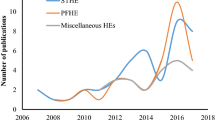Mathematical and numerical models of heat transfer in a package of materials for heat-protective clothing, which are solved for conditions of extreme cold and extremely low temperatures, are presented. Based on the results of a numerical experiment for the conditions typical for the territories of the Far North of the Russian Federation, the heat balance structure in the materials package and the components of heat transfer to the environment are established.




Similar content being viewed by others
References
GOST R 55858-2013, Materials for Clothes. Method for Determining the Total Thermal Resistance [in Russian], Standartinform, Moscow (2019).
A. Das, R. Alagirusamy, and P. Kumar, “Study of heat transfer through multilayer clothing assemblies: A theoretical prediction,” AUTEX Res. J., 11, No. 2, 54-60 (2011).
D. Fiala, K. J. Lomas, and M. Stohrer, “A computer model of human thermoregulation for a wide range of environmental conditions: The passive system,” J. Appl. Physiol., 87, No. 5, 1957-1972 (1999).
M. McQuerry, E. DenHartog, and R. Barker, “Ventilation of firefighter turnout gear: reducing heat stress and improving physiological comfort,” Proceedings of AATCC International Conference, 546-575 (2015).
E. Yu. Shamparov, S. B. Rode, I. N. Zhagrina, and M. P. Grigoryan, “Installation for measuring the thermal conductivity of light industry materials,” Dizain Tekhnol., No. 46 (88), 72-76 (2015).
Patent RU 166709 U1, Installation for Precision Non-Convection Measurements of Thermal Permeability of Materials at Temperatures Close to Room Temperature [in Russian], claimed by E. Yu. Shamparov and I. N. Zhagrina (2016).
A. Bejan, Heat Transfer, Wiley, New York (1993).
GOST 12.4.236-2011, Occupational Safety Standards System. Protective Clothing for Low Temperatures. Technical Requirements [in Russian], Standartinform, Moscow (2011).
Author information
Authors and Affiliations
Corresponding author
Additional information
Translated from Khimicheskie Volokna, No. 4, pp. 55-59, July-August, 2022.
Rights and permissions
Springer Nature or its licensor (e.g. a society or other partner) holds exclusive rights to this article under a publishing agreement with the author(s) or other rightsholder(s); author self-archiving of the accepted manuscript version of this article is solely governed by the terms of such publishing agreement and applicable law.
About this article
Cite this article
Abramov, A.V., Kirsanova, E.A., Shaitanova, M.M. et al. Method and Numerical Model for Assessing the Comfort of Heat-protective Clothing under Extremely Cold Conditions. Fibre Chem 54, 268–273 (2022). https://doi.org/10.1007/s10692-023-10391-0
Published:
Issue Date:
DOI: https://doi.org/10.1007/s10692-023-10391-0




